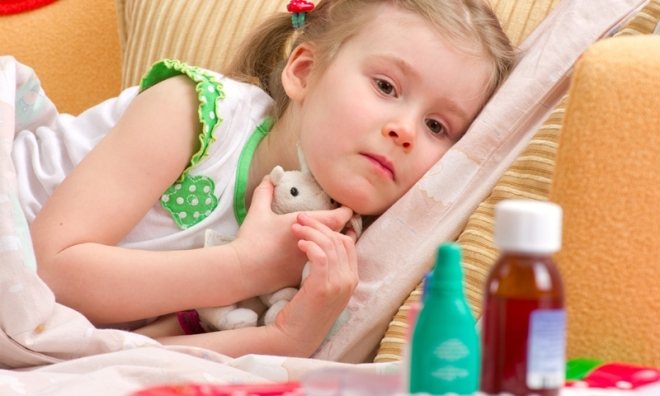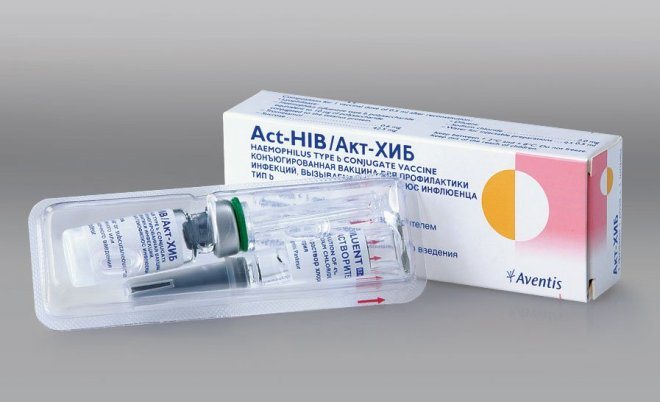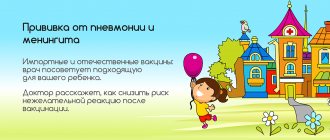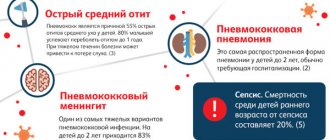Our expert is the director of the Research Institute of Preventive Pediatrics and Rehabilitation Treatment of the Scientific Center for Children of the Russian Academy of Medical Sciences, Doctor of Medical Sciences, Professor Leila Namazova-Baranova.
Today, parents do not know how scary it is when their baby is sick, for example, with measles - he lies with a temperature of forty and delirious. Or a severe form of whooping cough - coughing to the point of vomiting, it seems that he is about to spit out his lungs... It is only the grandparents of today's children who remember how they themselves suffered from childhood infections. Now almost all childhood infections have been defeated thanks to vaccinations. There used to be a million cases of measles a year. And now there are 27 throughout the country. Many childhood infections have been defeated, but not all. Hemophilus influenzae type b (abbreviated as Hib infection) still affects almost three million children in the world every year, causing severe purulent diseases such as meningitis, pneumonia, sepsis, as well as some forms of otitis media and arthritis. And about 386 thousand of these three million cases of Hib infection, alas, end in death.
HIB device
Hib infection is transmitted mainly by airborne droplets. That is, a carrier of this bacteria sneezed on a child on a bus, subway, store or in kindergarten - and that’s it, the likelihood of getting sick becomes real. Most often children from six months to 5 years old get sick. By six months, or even earlier, the baby runs out of protection received from the mother, and the body of children under 5 years of age is still unable to build an immune defense against Haemophilus influenzae.
Hib infection has several features.
The first is that it can be present in the body and for the time being not cause disease. It is believed that from 5 to 15% of children and adults are its carriers; Haemophilus influenzae lives in their nasopharynx and can be transmitted to other people, but the carriers themselves remain healthy. (Moreover, there are more small children among carriers than adults - up to 25%.) But as soon as the child’s body weakens - gets very tired, gets sick with something else, that is, as soon as his defenses decrease, the infection penetrates deeper and causes illness.
The second feature is that the bacterium causes not one, but several different diseases. The most severe of them is meningitis, inflammation of the membranes of the brain. In Russia, Hib infection is the cause of approximately half of purulent bacterial meningitis in children under 5 years of age. According to epidemiologists, every year in Russia from 300 to 1200 children aged from six months to two years become ill with CHIB meningitis. And the most common CHIB disease is pneumonia. Pneumonia caused by Haemophilus influenzae is recorded up to 10 thousand times a year. And the worst thing is at least 80 deaths a year from diseases caused by Haemophilus influenzae.
Continued: Vaccination against pneumonia →
The third feature is that Hib infection, like many diseases caused by bacteria, becomes less treatable with antibiotics the longer it goes on. Bacteria adapt and become resistant to drugs faster than people can invent new drugs for them.
Hemophilus influenzae infection can rightfully be called one of the most underestimated threats to the health of children in Russia. According to epidemiological studies, Haemophilus influenzae type b (HIB) is the cause of up to half of cases of purulent meningitis in children under 5 years of age. Moreover, up to 80% of the isolated strains are resistant to traditionally used antibiotics, and the frequency of severe, crippling complications after an infection reaches 40%.
However, the main danger of Hib infection is not even meningitis, but acute respiratory infections, including pneumonia and bronchitis, cellulitis. As well as abroad, in Russian kindergartens an extremely high level of infection is detected (up to 40% of children), which in turn is one of the main reasons for frequent colds in children attending or starting to attend kindergartens.
Vaccination is an affordable, safe and reliable protection against Hib infection. Modern Hib vaccines are almost 100% effective and can be used safely from the age of 2 months. Vaccinations against Hib infection are given to children under 5 years of age. Children over 5 years of age do not need vaccination, since the level of development of the immune system allows them to independently fight Haemophilus influenzae. Since 2011, vaccination against hemophilus influenzae infection has been included in the national schedule of preventive vaccinations for children 1 year of age from risk groups.
Vaccination against Hib infection is recommended for all children without exception in the first year of life, starting from 3 months of age. In economically developed countries (USA, UK, France, Canada, Finland, etc.), vaccinations against Hib infection are included in vaccination calendars. In the absence of routine vaccination, vaccinations are especially recommended:
- Formula-fed children, since they do not receive the necessary protective factors against Hib infection through mother's milk,
- Premature babies
- Children with immunodeficiencies of any origin
- Frequently ill children
- Those attending or planning to attend preschool institutions (nurseries, kindergartens),
The practical meaning of vaccination against Haemophilus influenzae for children under 1 year of age is to protect against the most dangerous forms of Haemophilus influenzae infection - meningitis and pneumonia, since the peak incidence of these forms of infection occurs at the age of 6-12 months.
For children who begin to be vaccinated over the age of 12 months, vaccination makes sense in terms of protection primarily against other Hib infections - acute respiratory infections and pneumonia (25% of cases in children under 5 years of age), acute otitis media (about 15% of cases), bronchitis (10–15% of cases).
The relevance of vaccination increases significantly for children planning to attend or already attending a nursery or kindergarten, since according to the results of Russian studies, it was found that in children's groups the proportion of CWD carriers reaches 40%. This is confirmed both by the frequent colds that are typical when starting to attend kindergarten, and by the effectiveness of vaccination against Hib infection, which can sharply reduce the level of carriage and the number of cases of acute respiratory infections.
The classic vaccination regimen includes 4 vaccinations at the ages of 3, 4.5, 6 and 18 months, together (on the same day) with DTP vaccinations. The main advantage of this scheme is the formation in the child of immunity to the most dangerous morbidity of CHIB meningitis and pneumonia at the age of 6–12 months.
Alternative schemes. If the child begins vaccination after 6 months of age, two doses are required one month apart and a booster dose at 18 months of age. All children over one year of age require only one vaccination.
It is recommended to combine vaccination against Hib infection on the same day with vaccination against diphtheria, tetanus and whooping cough, which allows you to simultaneously protect against 5 infections and reduce the number of visits to the doctor. The duration of immunity after vaccination is sufficient to protect a child until the age of 6 years, that is, until the child is able to independently develop immunity to Haemophilus influenzae.
Vaccines against Haemophilus influenzae are well tolerated. Induration, redness, and soreness at the injection site may be observed (in 5% of vaccinated people). Temperature reactions are rare, occurring in 1% of vaccinated children.
The only way to protect
What to do? Get vaccinated. This is the only effective way to combat Haemophilus influenzae. If you take a map of the world and color in the countries where vaccination against Hib infection is included in the National Vaccination Calendar and is considered mandatory, all of North and South America, Europe, Australia, and even half of Africa will be colored. Vaccination of all children against this infection is already practiced in 133 countries around the world. But, alas, we don’t have it yet. But vaccines against this infection are registered in Russia, so parents who want to protect their child from the risk of getting very unpleasant and serious diseases can do this themselves - vaccinate their child for a fee. In a children's clinic, in a vaccination center, in a pediatric medical center.
It is clear that every mother who looks at the baby’s tiny body worries about how her baby will survive the extra injection, and so they give him so many vaccinations! In fact, the Haemophilus influenzae vaccine can be administered simultaneously with any others. And you won’t need additional injections if you use a combined vaccine against several infections at once: diphtheria, tetanus, whooping cough, hepatitis B, including Hib.
Vaccination is best started at three months, the next doses should be administered at four and a half months, six months and one and a half months. But if you realize it later, it’s okay: there are vaccination schedules for children older than 6 months and older than one year.
The injection is given to infants in the thigh, and to children after two years of age - in the upper part of the shoulder. There is no need to buy the vaccine at the pharmacy; there are certain storage conditions for it that you may not know. It is better to use the vaccine from the medical institution where you will be vaccinated.
We are all very afraid of adverse reactions that can happen after any vaccination. The child seemed to be cheerful and healthy, but with our own hands we caused his temperature to rise and the injection site to become red and painful. Yes, there are no completely neutral vaccines. The introduction of any of them may cause an adverse reaction. But it normal. The child’s immunity to the infection that causes the disease will not get worse. And some experts believe that it will even become more active. It’s better to endure a rise in temperature for one day and the whims of a baby whose injection site itches than to watch your child suffer from pneumonia or meningitis. God forbid anyone to experience this. By the way, the Hib vaccine is least likely to cause any reactions.
When should a child be vaccinated?
It turned out that it is very difficult to obtain a lasting immune response in children under two years of age. Therefore, their vaccination schedule is complex. The vaccine is administered at three, four and a half and six months, and then revaccinated at 18 months.
Children from two to five years old need only one vaccination to develop lasting immunity.
It is important! By getting one vaccination against hemophilus influenzae, you will help your child cope with the onslaught of unfamiliar microbes in the first days and months of visiting a children's group.
Pharmacological action Act Hib
The Hib Act is not included in the compulsory vaccination schedule, however, experts strongly recommend the introduction of this vaccine due to the high prevalence of infections with the pathogen Haemophilus influenzae type b. It refers to bacteria of the opportunistic type, which, with a weakened immune system in a child, provoke the following diseases:
- ARVI;
- Otitis;
- Meningitis;
- Bronchitis;
- Arthritis;
- Otitis;
- Sepsis;
- Pneumonia;
- Epiglottitis.
The Act Hib vaccine is intended for the prevention of purulent-septic diseases caused by the pathogen Haemophilus influenzae type b. It forms specific resistance to a given pathogen and helps stimulate the appearance of antibodies. As a result, B lymphocytes are activated by stimulated T lymphocytes through lymphokines (immune mediators). This is the reason for the immunostimulating effect of Act Hib.
It is important to note that in the case of repeated vaccinations, a pronounced booster effect is observed. It is evidence of the formation of immunological memory acquired as a result of the initial injection.
Act-HIB or Hiberix: which is better to use for hemophilus influenzae infection?
There is no specific answer to this question. The choice of drug for vaccination will depend on the patient's age, health status, and the need for vaccination against additional infections.
Hiberix vaccine
In any case, the choice of drug should be made by a doctor. If you don’t like the vaccine they offer you at the clinic, you can always buy any analogue and get vaccinated with it.
But in any case, when using a synonym, do not forget to consult your doctor. Perhaps the doctor will help you choose a vaccine that is more affordable in cost and composition.
What kind of Act-HIB vaccine is this, and what does it help with?
The abbreviation “HIB”, which stands for vaccine, has the following meaning: a drug against the bacterium Haemophilus influenzae bacilli type b. The Hib vaccine is designed specifically to protect the body from this type of bacilli, since other strains do not pose a serious threat to the health of the child.
Haemophilus influenzae is transmitted by airborne droplets and household routes. This means that the risk of infection is very high. You can “catch” an infection not only through close contact with a sick person, but also through sharing toys, towels, dishes, and bed linen, which is especially dangerous in preschool settings.
When a microorganism enters the body in small quantities, it does not provoke pathogenic processes; the person simply becomes a carrier of the infection. In the opposite situation, the bacterium causes the development of various diseases. Both options are not normal. Even if the disease has not developed at the time of infection, then if any situation arises that leads to a weakening of the immune system, there is a risk that the bacillus will begin to multiply intensively.

The risk group includes children from six months to five years. Children under one year of age are at greatest risk of developing complications.
On the part of the respiratory system, tracheitis, bronchitis (often becomes chronic), pneumonia (one of the most severe, severe manifestations), epiglottitis (causes suffocation) develops; Sepsis (a common consequence of many diseases of the hemophilic group), arthritis, otitis, and conjunctivitis may occur. A very terrible consequence of infection is meningitis, since about 15% of cases of the disease are fatal. This complication causes organic damage to the brain, often taking on the most dangerous - purulent - form.
Hib infection can provoke the development of acute respiratory diseases, cellulitis, septicemia, and pericardial damage. Haemophilus influenzae type b is dangerous due to its enormous resistance to antibiotics, which makes treatment of the patient more complicated. In addition, the acute course of the disease is often asymptomatic, and clinical manifestations become noticeable after the development of complications. Therefore, the vaccine against Hib infection is of great importance in the preventive vaccination schedule.
The manufacturer of the Act-HIB vaccine is a French pharmaceutical company. The drug underwent registration with the Ministry of Health of the Russian Federation in December 1997 and has since been successfully used to immunize the population.
Composition and release form
Act-HIB is available in the form of a lyophilisate in 0.5 ml bottles. The instructions for use contain detailed information about the composition of the vaccine.
Active substance
The main component aimed at developing immunity against Haemophilus influenzae type b is a polysaccharide from the surface of the bacterium. The polysaccharide is conjugated with tetanus protein. The vaccine does not contain the live bacterium Haemophilus influenzae, so it is not capable of causing vaccine-associated infection.
pharmachologic effect
The pharmacological effect of the vaccine is based on the prevention of infection with the causative agent of Hib. However, Hib vaccination does not protect against diseases caused by infections other than Haemophilus influenzae type b. That is, the effect of the vaccine is aimed solely at preventing the development of Hib infection in the body and, as a consequence, possible complications. It will not protect against meningitis and pneumonia, as such. The same goes for tetanus. The vaccine contains tetanus toxoid, but is not the same as the tetanus shot. Vaccination against this disease is carried out separately, according to the schedule of preventive vaccinations.

Efficiency
The effectiveness of Hib vaccination has been proven through research. With mass immunization, the number of infection carriers was reduced from a critical 40% to an acceptable 3%. If we take statistics for the regions in which vaccination was carried out, it is worth noting a decrease in the number of Hib infections by 90%. The statistics took into account only cases of diseases caused by Haemophilus influenzae.
Based on the results of clinical screenings of vaccinated children, manufacturers claim that stable immunity has formed in 95% of patients. At the same time, it persists for 4 years. This is enough, because by the end of the specified period the child will have developed a sufficient number of antibodies to fight the infection on his own. Repeated vaccination is not required.
Drug interactions
Studies have not revealed any negative cases of drug interactions between Act-HIB and other drugs. Combination with other vaccines included in the preventive vaccination schedule is allowed. However, during the pre-vaccination examination of the child, parents are required to provide the pediatrician with information about the medications they are taking.
Contraindications
According to the instructions for Act Hib, this vaccine is contraindicated in case of individual intolerance to its components, in particular to tetanus toxoid. In addition, if a child has an acute illness or in cases of exacerbation of an existing chronic illness, vaccination should be postponed. It is recommended to carry out an injection in such situations only 2 or even 4 weeks after the child has fully recovered.
Also, the instructions for the Hib Act warn that mild forms of respiratory infection or intestinal infections are also a reason to postpone vaccination. It can be carried out only after the baby’s body temperature has normalized.
It should be added that Act Hib does not form immunity to meningitis of other origins and to other types of the pathogen Haemophilus influenzae. Also, the tetanus protein included in this vaccine cannot replace a childhood tetanus vaccination.
According to reviews of Act Hib, children who are on immunosuppressive therapy or who are immunocompromised have a weak immune response to the vaccine.
Composition, release form and analogues
Act Hib is available in the form of a lyophilisate for the preparation of a solution for subcutaneous and intramuscular injections along with a solvent. 1 dose of vaccine contains:
- 10 mcg of Haemophilus influenzae type b polysaccharide and 18-30 mcg of conjugated tetanus protein (active ingredients);
- 0.6 mg trometamol, 42.5 mg sucrose (excipients);
0.5 ml of solvent (sodium chloride solution 0.4%) contains 2 mg of sodium chloride and up to 0.5 ml of water for injection.
Vaccine Act Hib is a white homogeneous lyophilisate, and the solvent is produced in the form of a colorless transparent liquid. One cell package contains a bottle with 1 dose of vaccine and 0.5 ml of solvent in a syringe with a fixed needle. In cases where the needle is not attached to the syringe, 2 separate sterile needles are included in the package.
The main analogue of the Act Hib vaccine is Hiberix, produced in Belgium.
Side effects
According to reviews of Act Hib, after administration of the vaccine, in some cases, side effects may be observed in the form of pain, redness, swelling and hardness at the injection site.
In addition, the vaccine can also cause:
- Edema of the lower extremities;
- Itching;
- Rash;
- Transient purpura;
- Febrile or afebrile seizures;
- Vomiting;
- Irritability and prolonged crying;
- Urticaria;
- Temperature rise above 39 °C.
Such side effects occur in most cases when Act Hib is administered as part of combination vaccines, for example, against tetanus, diphtheria and whooping cough. They usually go away without residual effects on their own within 24 hours.
Some reviews of Act Hib indicate that the vaccine may cause an increase in the interval between respiratory movements in premature babies (born at 28 weeks or earlier).






